Questions? Contact Ellen Paparozzi, Nebraska's professor emeriti of agronomy and horticulture.
New for 2020
Year-round Strawberry Production – Nebraska Propagation Techniques
Alan Weiss, Papio Valley Nursery, and Nebraska's Ellen Paparozzi have started research aimed at year-round production of strawberries in Nebraska. The first step, started May 2020, is to work on plant propagation and production of dormant strawberry crowns for winter-growing. If successful, commercial growers will have locally sourced plants and dormant crowns for field or pot culture. Commercial growers will also be able to try new and different cultivars that have already been successfully grown in Nebraska.
Our Field Setup
Last Fall, crowns of strawberry cultivars Honeoye, Evie-2 and Seascape were potted, grown for a few weeks and then overwintered. May 19 and 20,2020, a crew of 3 planted approx. 300 plants out in the field. A mother-hill type system was set up with weed barrier across the field and a drip system with individual drippers to each plant was set up. Flowers or fruit that was present were removed. On June 11, 1 teaspoon of Greenway Biotech fertilizer plus micronutrients 8-12-32 was side-dressed to each plant.
This Fall we will harvest the runners and pot those up to produce more runners and store the mother plants as dormant crowns (in the future these would be for sale for winter growing).
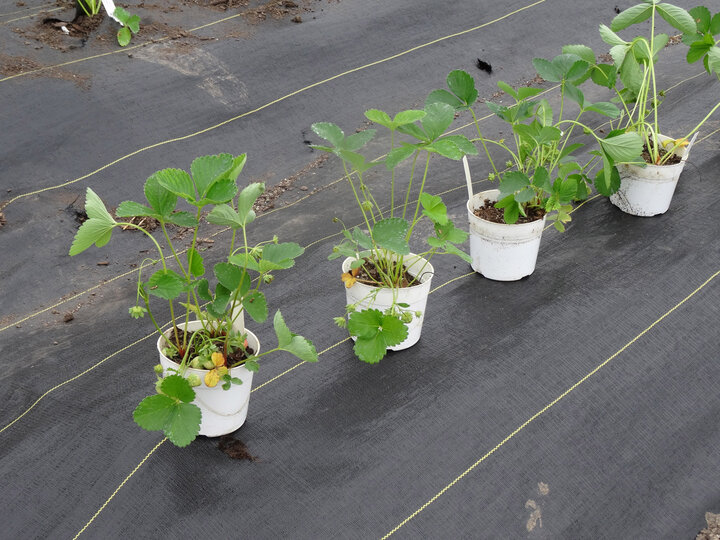
Strawberry plants that were overwintered in pots.

Lining out plants to be approximately 12 inches apart.
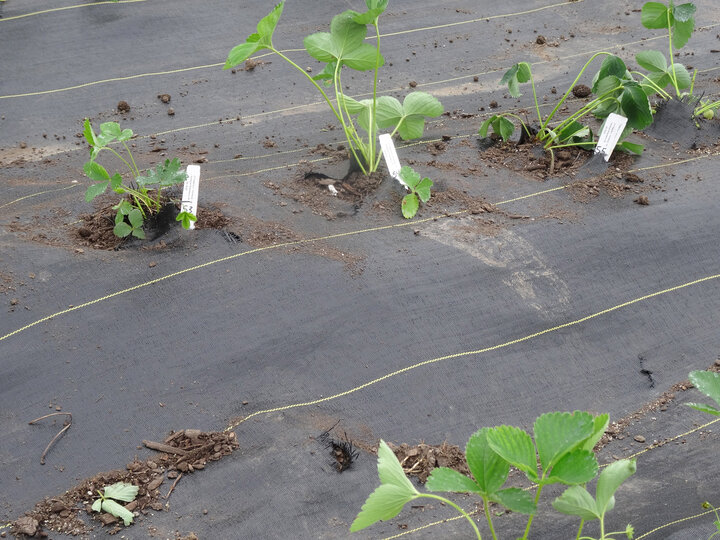
Plants before drip lines were added. To plant into the weed barrier, large X’s were cut and the edges pushed under the cloth to create a square.
June 26, 2020 Strawberry update
‘Honeoye’ (a June-bearing strawberry type)
Seventy-eight of the 80 plants survived transplant. Only one plant still had flowers. The rest all were producing stolons. Most stolons had 2 plantlets starting to grow.
‘Seascape’ (an ever-bearing strawberry type)
Seventy-four of 76 plants survived transplant. Many plants were still producing flowers and fruit, which were removed. A few plants had started to produce stolons.
‘Evie – 2’ (an ever bearing strawberry type)
All 84 plants of Evie-2 survived transplant. Most of the plants were still producing flowers and fruits, which were removed. This cultivar would be good for a home or commercial/ U-pick use if it survives Nebraska winters.
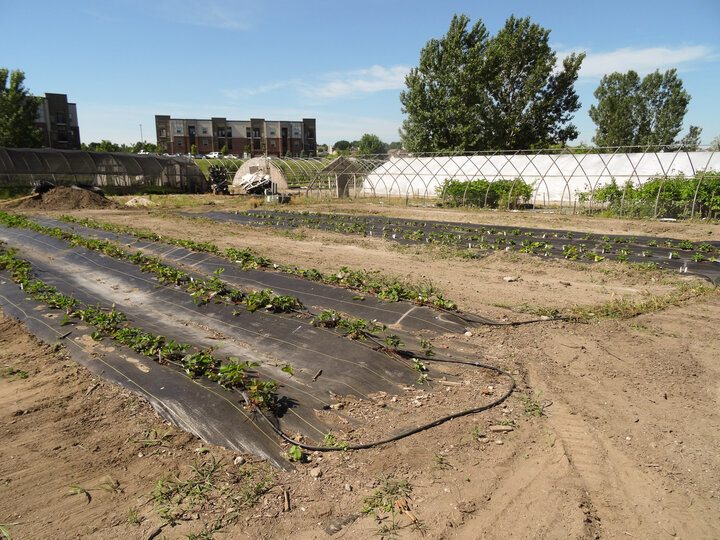
Open field area being use for strawberry production.

Stolons on ‘Honeoye’ strawberry plants (arrow).

Flowers and fruit on an ‘Seascape’ strawberry plant.
July/August Update
While July was one of the wettest on record for Nebraska, there were also many days when the temperatures were in the high 80’s and 90’s often with high winds. On those days, the strawberries were drip irrigated for 1 hour 3 times per day (morning, noon, afternoon). Even though this field is very open, this irrigation method has worked!
Labor
Labor is always an issue with growing any type crop. To date, here is how much time has been devoted to these plants.
- Each week, since planting, four people spend about 30-45 minutes checking plants, weeding, removing flowers and berries.
- Fertilizer was applied twice this summer and it took 1 person 2 hours.
- Cutting and opening up the fabric to accommodate stolons (runners) took 4 people 2 hours (Figure 1).
August 13 update
All cultivars still have a few plants that are producing flowers/fruit. ‘Honeoye’ plants were producing the most stolons (stolons) followed by ‘Seascape’ plants. Plants of ‘Evie-2’ were producing the fewest stolons and had the highest number of plants till producing fruit/flowers (around 10-15 plants). It’s important to note that plants that were not producing stolons were not producing flowers/fruit. Thus, the presence of stolons is independent of the presence of flowers/fruit.
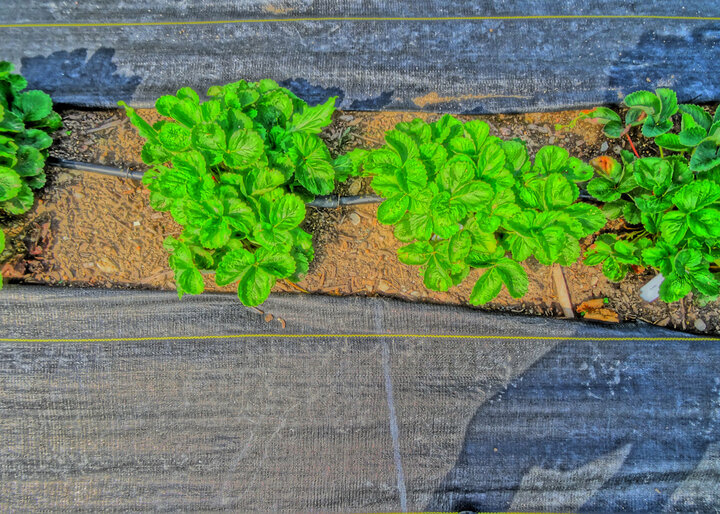
Figure 1. Fabric was opened up so stolons could root.
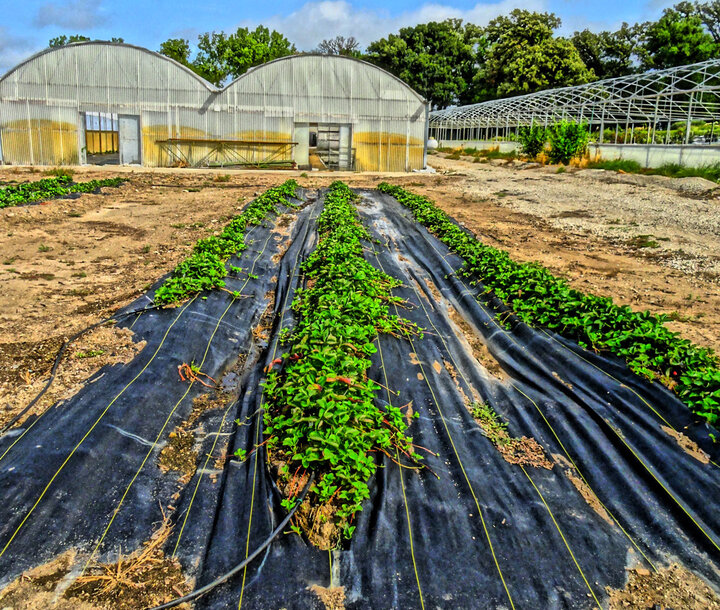
Figure 3. Looking north, plants of ‘Honeoye’ (two rows on the right) and one row of ‘Seascape’.
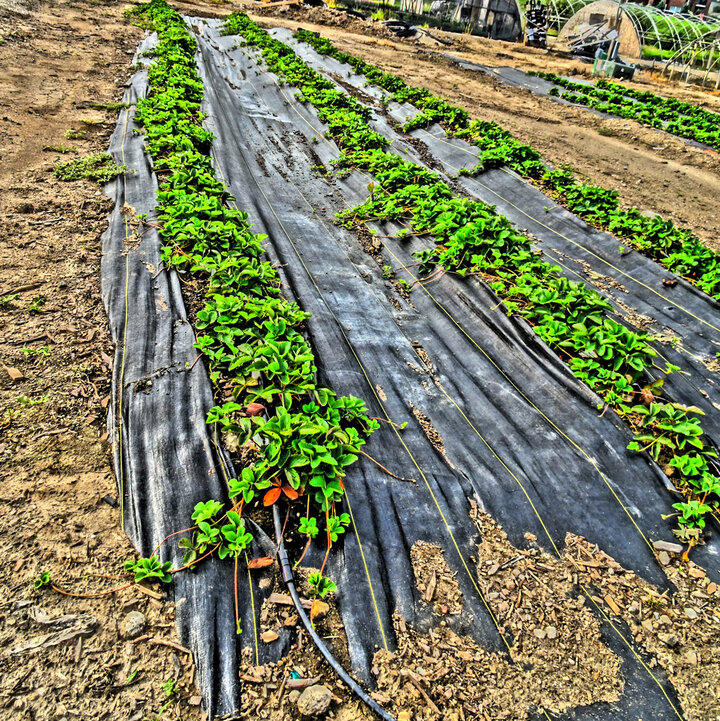
Stolons on ‘Honeoye’ plants
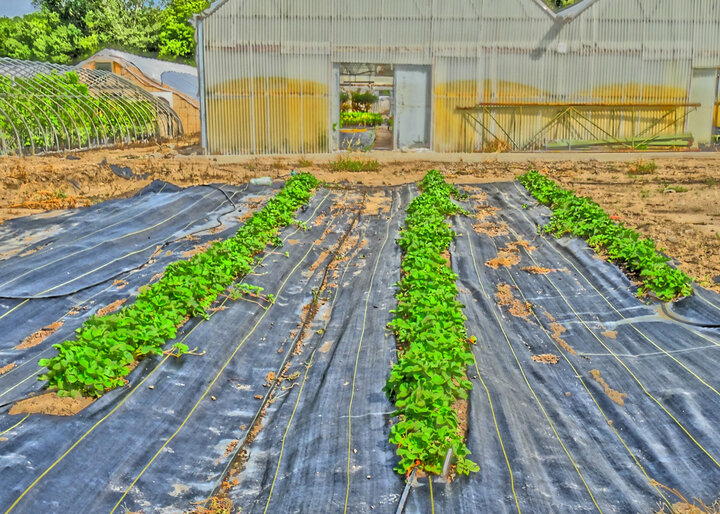
Figure 4. Pointing north, plants of ‘Evie-2’ (two rows on the left) and one row’ of ‘Seascape’.
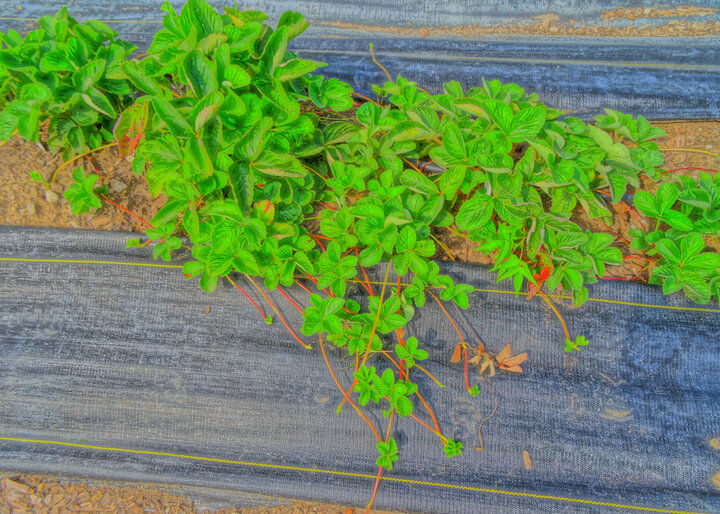
Figure 2b. An artsy picture of stolons on ‘Honeoye’ plants.
October Update
On October 14, we harvested stolons and planted 150 plantlets for each of the three cultivars (see table below). The number of plantlets on each stolon ranged from one to ten! This process took two people 6 hours plus one person 0.5 hour. It was definitely labor intense! The plantlets were potted up in 4” square pots, which contained a peat perlite-based mix. The greenhouse they are growing in is double poly air-inflated with shade cloth. It is heated by cables on the ground. This bottom heat will be set for 700F to help rooting and the day temperature will set at 800F. The plantlets will be misted as needed and a fungicide will be applied in about 5 days. Once rooted they will be grown at temperatures according to the weather. As the temperature decreases outside, the interior temperature will be dropped. The final day temperature will be between 40-45 0F. In August, we widened the space between the plants (removed the weed barrier) so within the row was all open. As a result, many of the previous stolons had rooted within the row. This made it impossible to count plants within the row. We were surprised to see that a few plants that had flowers and fruit. This was true for all three cultivars.
| Cultivar | Number of stolons | Number of plantlets | Comments |
|---|---|---|---|
| Evie 2 | 254 | 536 | Started with 84 plants |
| Seascape | 237 | 832 | Started with 74 plants |
| Honeoye | 851 | 1782 | Started with 100 plants |

Figure 1. Partial field view of plants (10-14-2020).
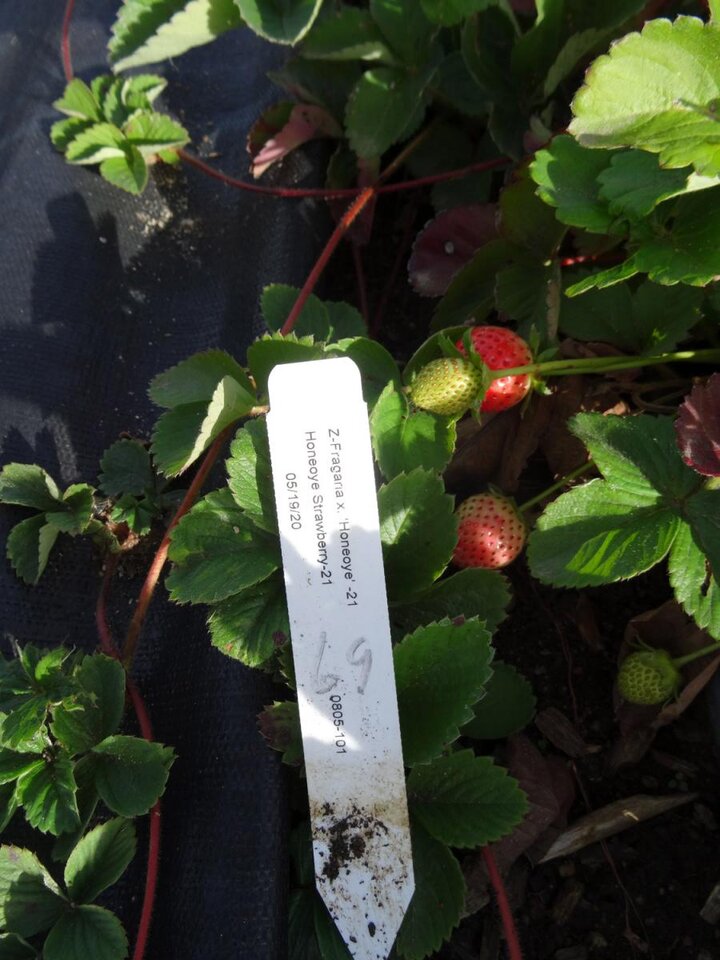
Figure 2. Fruit in October! Probably due to a warm September.

Figure 3. Stolons rooting in the fabric.
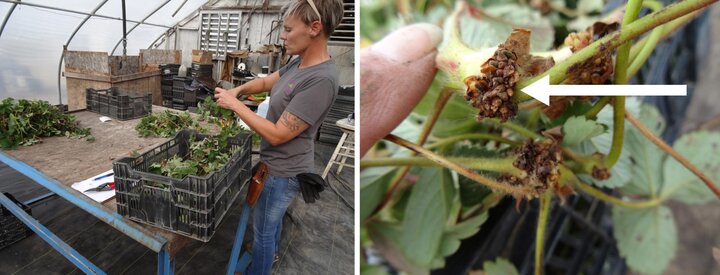
Figure 4. Plantlets that were selected for propagation had 3 to five leaftlets and rootlets present (arrow).
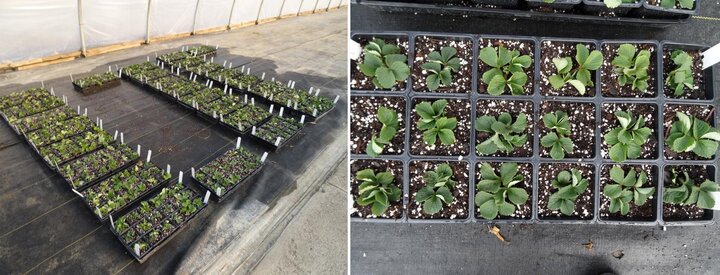
Figure 5. Plantlets in the greenhouse. There were a total of 450 plantlets.
November Update
The cold storage facility was scheduled to be up and running by Thanksgiving so it was time to lift all the crowns and prepare the ground for next year. In order to store dormant crowns, plants need to be removed from the field (Figure 1, 2), graded (Figure 3, 4), have all the soil removed from the roots and then have the leaves trimmed off (Figure 5). We split them out into 3 grades – small, medium and large. The large grade consisted of crowns that were at least as thick as a human index finger and had lots of leaves and roots. The medium grade had crowns that were about as thick as a pencil with some leaves and good roots. The small grade were mostly plantlets. For each cultivar, 50 large and 50 medium crowns were stored in bundles of 10 (commercially they are usually bundled in units of 25). To bundle, we wrapped them in newspaper with the crowns visible at the top and then secured them with a rubber band (Figure 6). Then crowns were then laid on shredded newspaper in a sterilized (with alcohol) black plastic bulb crate. Once in the crate we removed most of the bottom half of the newspapers so the roots were visible and could be misted as needed. To harvest just ‘Honeoye’ and ‘Seascape’ crowns, it took six people 6.5 hours plus the driver of the bucket loader, which was used to dig out the crowns.
| Cultivar | Number of Large Crowns | Number of Medium Crowns | Number of Small Crowns/Plantlets | Total |
|---|---|---|---|---|
| Evie-2 | 176 | 201 | 388 | 765 |
| Seascape | 193 | 337 | 425 | 955 |
| Honeoye | 256 | 701 | 1163 | 2120 |

Figure 1. Strawberry plants showing Fall color (November 2020).
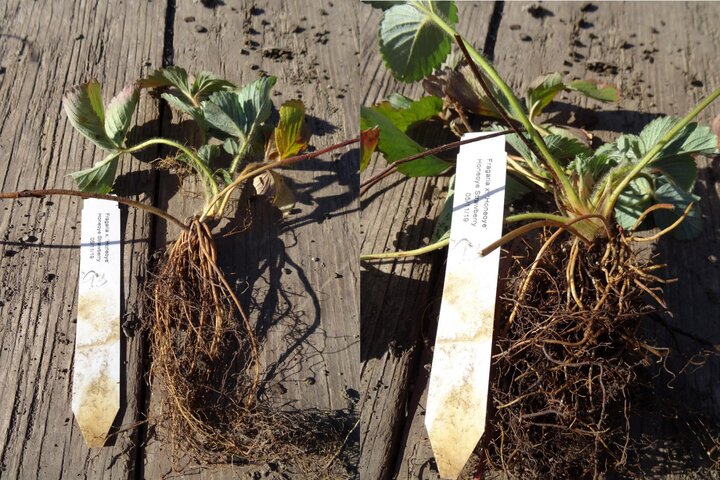
Figure 4. Large sized crowns of ‘Honeoye’.
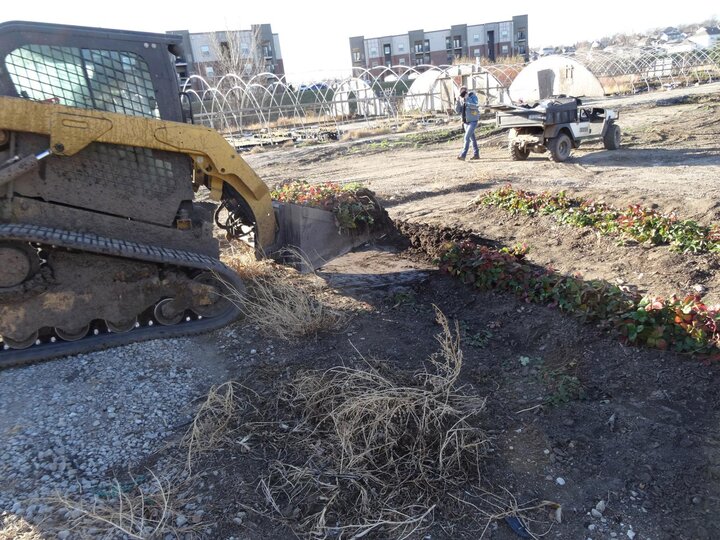
Figure 2. Lifting the crowns so they could be harvested.
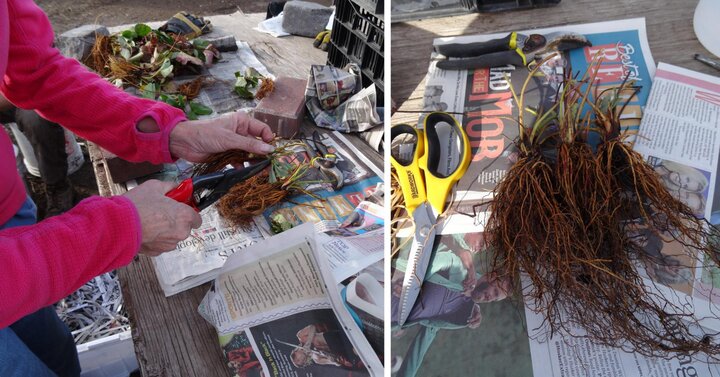
Figure 5. Trimming off the leaves. Roots have been washed completely free of soil.
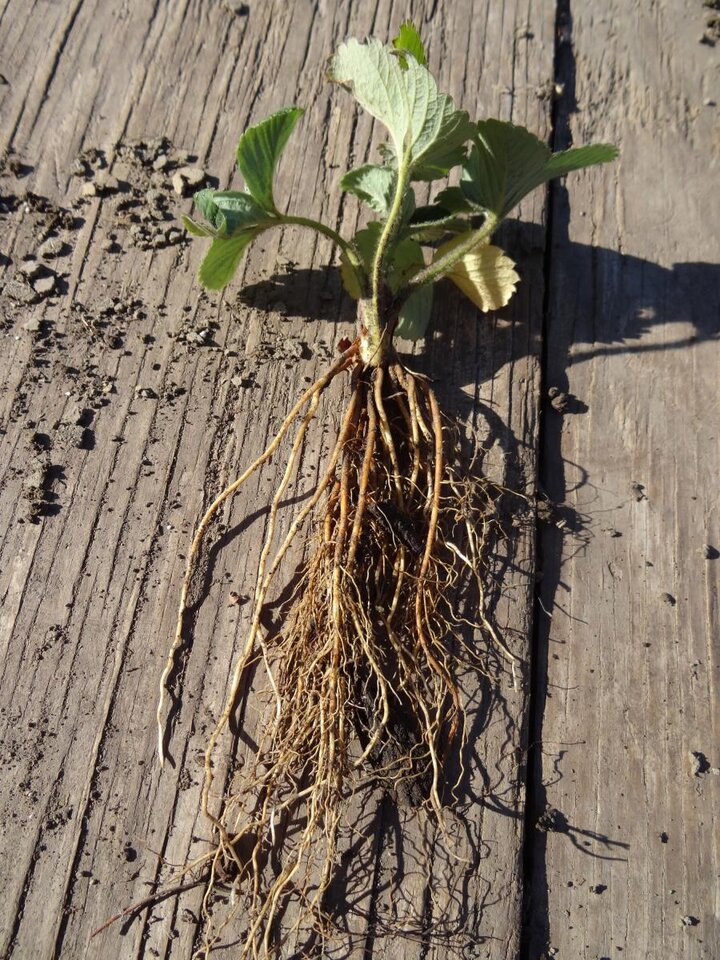
Figure 3. Medium-sized crown of ‘Honeoye’.

Figure 6. A bundle of 10 large crowns of ‘Honeoye’. The bottom of the newspaper was removed to reveal the roots once the crowns were in the cold storage.
December Update
All plantlets that were harvested and propagated in October are well rooted and have been put into cold storage (40o F). They at least need 200 hours of cold in order to flower. In January, they will be removed from cold storage and eased back into growing for planting in April.
The dormant crowns that have been bundled in units of 10 were doing well until December 14. When they were misted, it was noted that grey mold (botrytis) was starting to grow (Figure 1, 2). In an effort to beat the botrytis, they were unwrapped and sprayed with Agrowlyte Plant Wash (Figure 3). It appears that the mold is gone so they will be rebundled without the newspaper, set on top of the crates (which will also be sprayed) and the airflow will be directed towards them. Hopefully, this will hold them until we can get BotryStop from Bioworks and apply it to them.
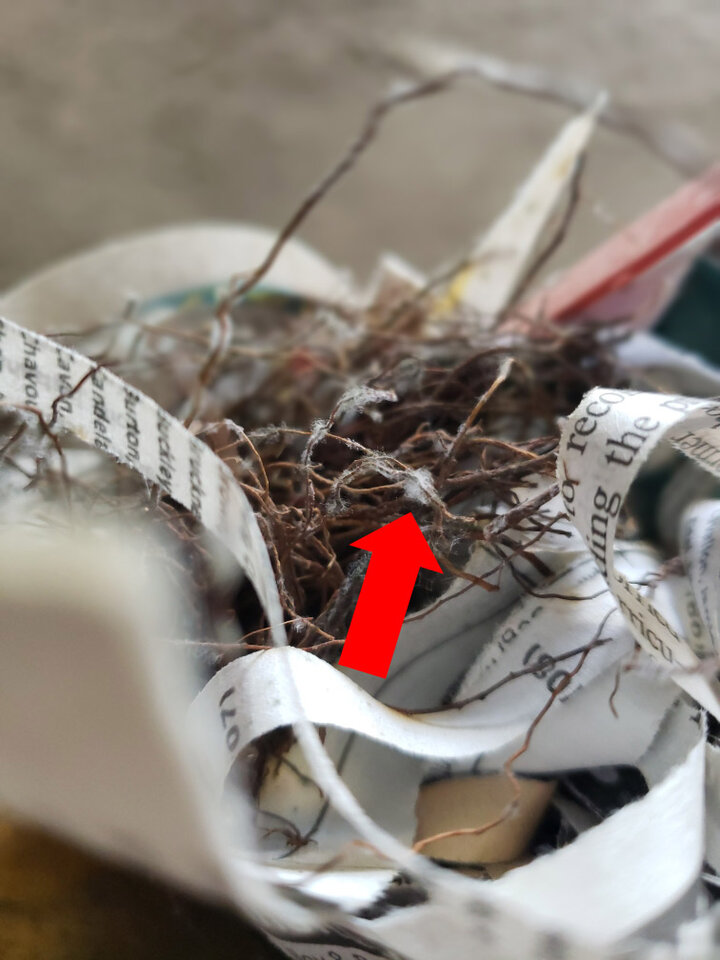
Figure 1. Gray mold (botrytis) on the roots of dormant strawberry crowns.
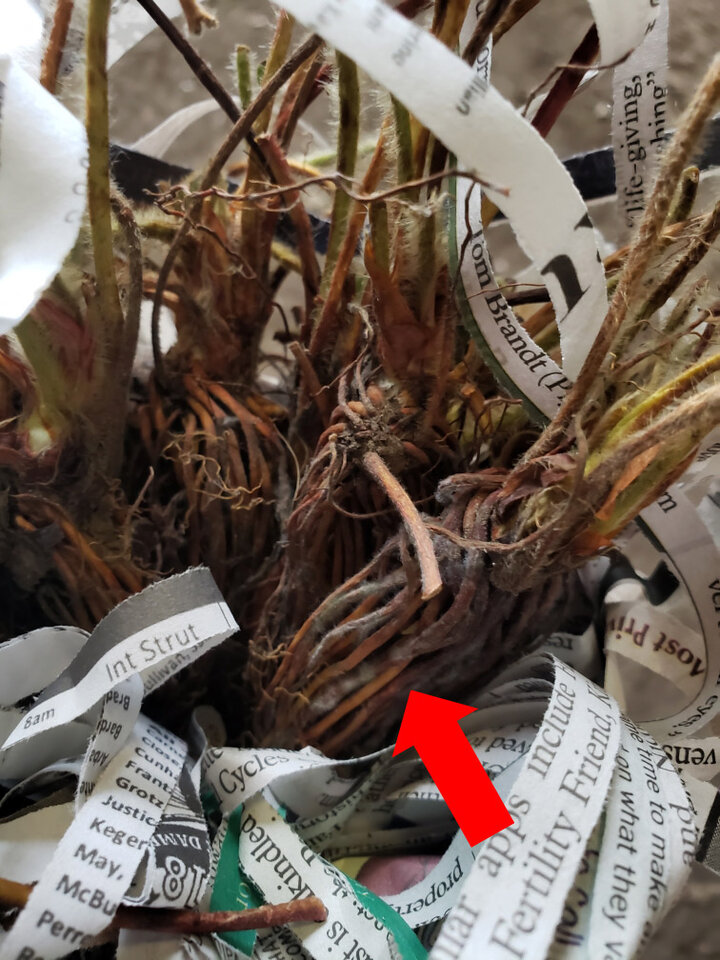
Figure 2. Gray mold starting to move near the crowns.

Figure 3. Plant on left has gray mold on the roots. Plant on right has been dipped and rinsed in Agrowlyte. The mold seems to have disappeared.
January – February Update 2021
Rooted plantlets
All plantlets that were harvested and propagated in October are well rooted and have been put into cold storage (40o F). They at least need 200 hours of cold in order to flower. In January, they will be removed from cold storage and eased back into growing for planting in April.
December 4, 2020 the well-rooted plantlets were move to the cold storage facility (38-41oF; 83-89% relative humidity). They are being treated like any other perennial plant to facilitate the concept of strawberries aa part of routine nursery production.
On January 18 – after the plantlets have received at least 200 hours of cold, they were moved with other perennials to a floor-heated greenhouse (Figure 1). Temperatures range from 56-79oF during the day with the fans coming on at 75oF. They are received only water through February. Regular fertilization will start in March. Hopefully the fertilizer will reduce the spurious flowering that is occurring (Figure 2).
The plantlets did not have any mold problems because they and the perennials were sprayed November 23 with Subdue Maxx.
Dormant crowns
The BotryStop at 0.64 ounce/1 gallon was applied December 22. By January 5, 2021 all crown roots were colonized by the fungal growth due to BotryStop. Roots are still fleshy and not dried out.
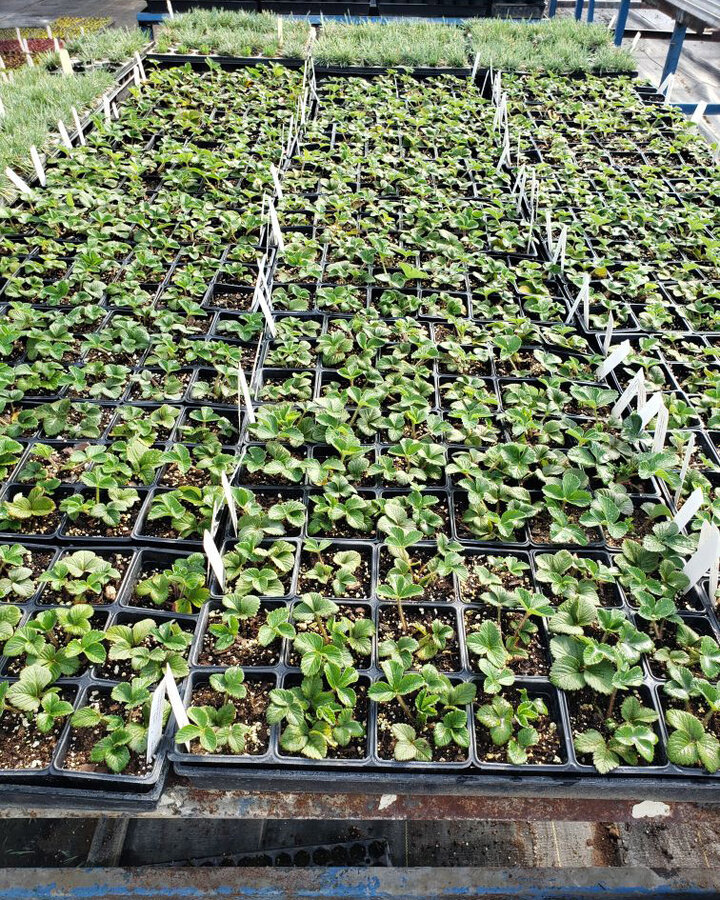
Figure 1. Rooted plantlets were returned to the greenhouse and are growing alongside of nursery perennials.
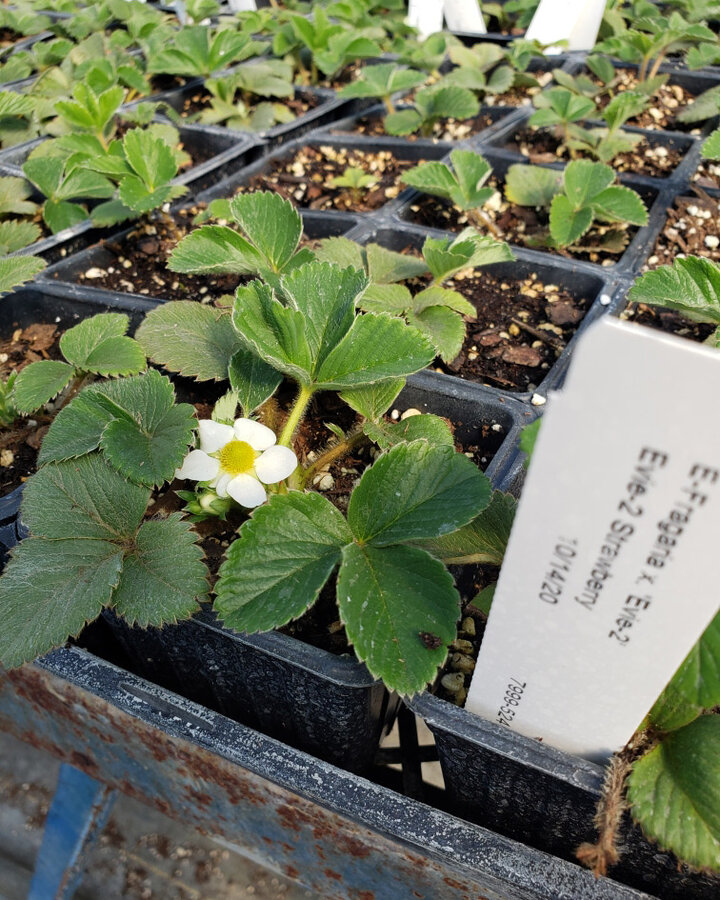
Figure 2. Flower buds on Evie-2 strawberry plants which were propagated October 14, 2020.
Spring 2021
Strawberry bed preparation and planting
In early April black polyethylene sheets were pinned down on the field in order to solar pasteurize the soil. Earlier, the strawberry plants that were propagated from stolons were moved out of cold storage into the greenhouse (Figure 1). Within a week, many plants started flowering. Plants of all three cultivars – Honeoye, Evie-2 and Seascape were ready to be sold or planted.
About 4 weeks later, the poly was removed from the field, the soil tilled and planting mounds created. There were 6 rows of mounded soil that were created. New weed barrier was placed on the field and the drip irrigation was setup.
Monday, May 3, 2021 our crew arrived to plant the dormant crowns and the stolons that had been propagated, grown and then stored in cold storage. The weed barrier over each mound was cut and pinned back so that 15 large dormant crowns and 15 medium dormant crowns were planted for each cultivar (Figure 2). In separate rows, thirty of the propagated stolons for each cultivar were planted. Over all six rows there were a total of 180 strawberries planted. All strawberries were planted 16” apart.
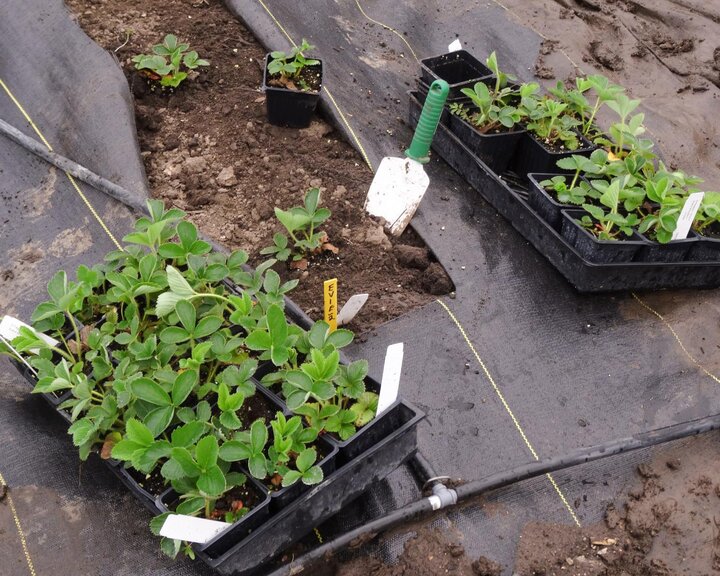
Figure 1. The strawberry plantlets that were propagated from the stolons last fall.

Figure 2. Large dormant strawberries crowns were planted on 16-inch centers.
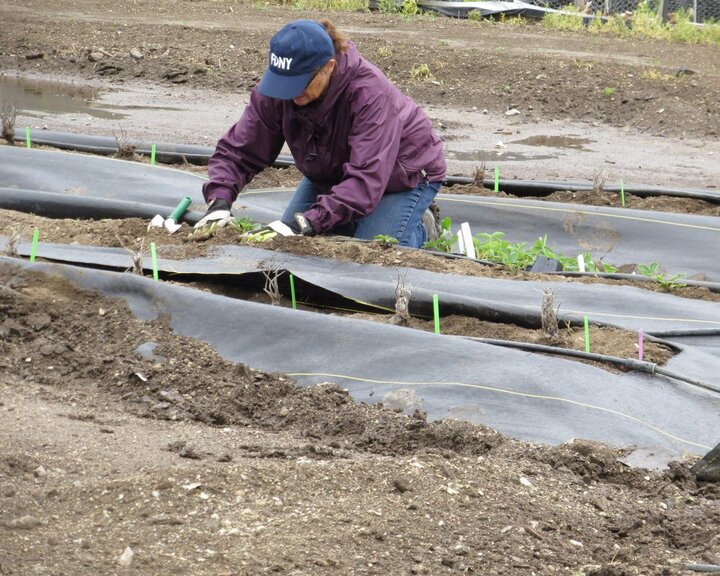
Figure 3. For each cultivar, the field pattern was a row of propagated stolons then a row of dormant crowns.
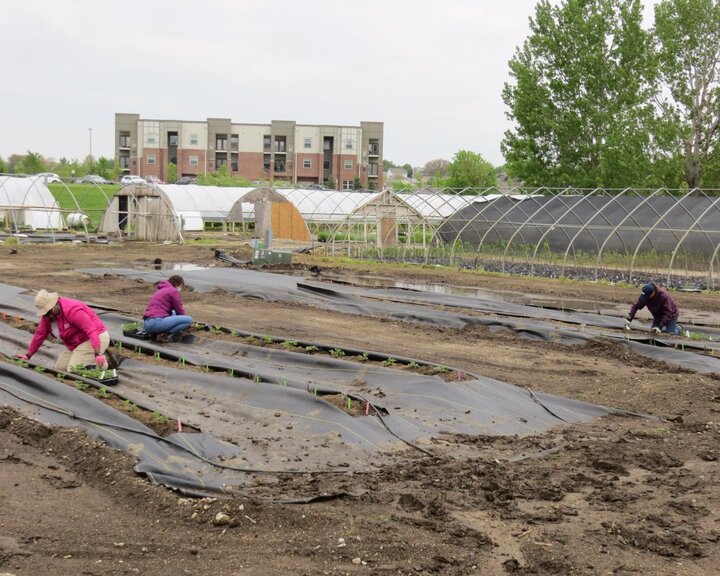
Figure 4. Field planting. The green labels are the large crowns and the orange labels are the medium crowns. There were small white labels for the propagated stolon plantlets.
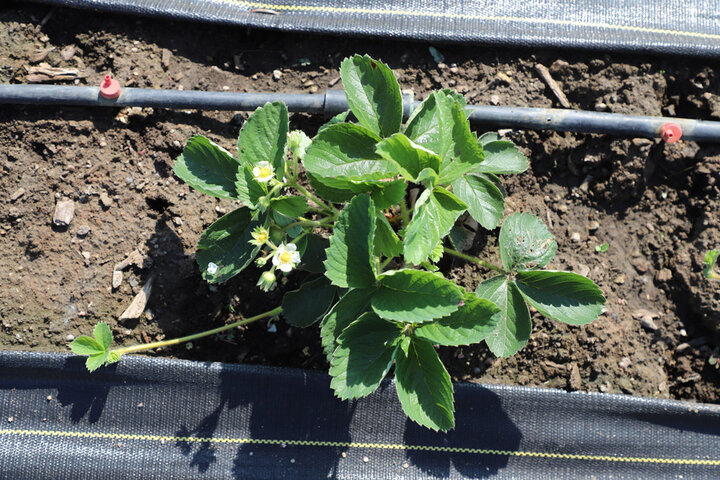
June 2021
Of the 45 large dormant crowns across the 3 cultivars only 1 is still alive. For the medium size dormant crowns across all cultivars, only 2 are alive. Thus, the dormant crown harvest and storage experiment was unsuccessful. There are a number of factors that play into this. First, the cold storage was new and the temperature when they went in in November and December was not regular. They were harvested and stored in bundles with newspaper around the roots to keep them moist. Soon after there were potted perennials that were also brought into the storage. The bundling encouraged powdery mildew and so the plants were removed from the bundles and laid out. They were sprayed with a biocontrol fungicide which appeared to work. The crown area itself appeared to be healthy when planted but obviously was not. If we were to do this again, we would take a section of the cold storage, make it clean (no soil), stabilize the temperature, create an automatic mist system for humidity, lay out the crowns so that there was plenty of air circulation and apply the biofungicide before there is a problem.
The propagated plantlets from the stolons are alive, flowering and fruiting. Most plants have produced at least 2 or 3 berries with more on the way. This is a conservative estimate as we could not harvest berries every week. However, on June 30 when we did harvest, thirty plants of ‘Honeoye’ had 31 harvestable fruit; ‘Seascape’ had 64 and ‘Evie-2’ had 27. Of interest is that all cultivars are now producing stolons (Figure 1). Some of these have plantlets are already developing root nodes so would be ready for propagation.
Figure 1. Stolon formation on strawberry plants (June 16, 2021).
October 15, 2021
Members of the strawberry team (Figure 1.) harvested all the remaining stolons and counted the number of plantlets (Figure 2) that could be propagated. Thirty plantlets of each cultivar were then planted, just like last month. The plantlets from last month were already rooted and could have been sold for Fall planting. Actually, Fall is the best time to establish a strawberry bed rather than spring when the plants are traditionally sold. In a small area (like a home garden), plants planted in August and September will overwinter and be ready to grow in April and May and produce more fruit in June than small plants purchased in spring. Fall planting on a large scale, may require straw mulch to insure winter survival.
| Cultivar | Number of plantlets |
|---|---|
| Evie-2 | 445 |
| Honeoye | 215 |
| Seascape | 430 |
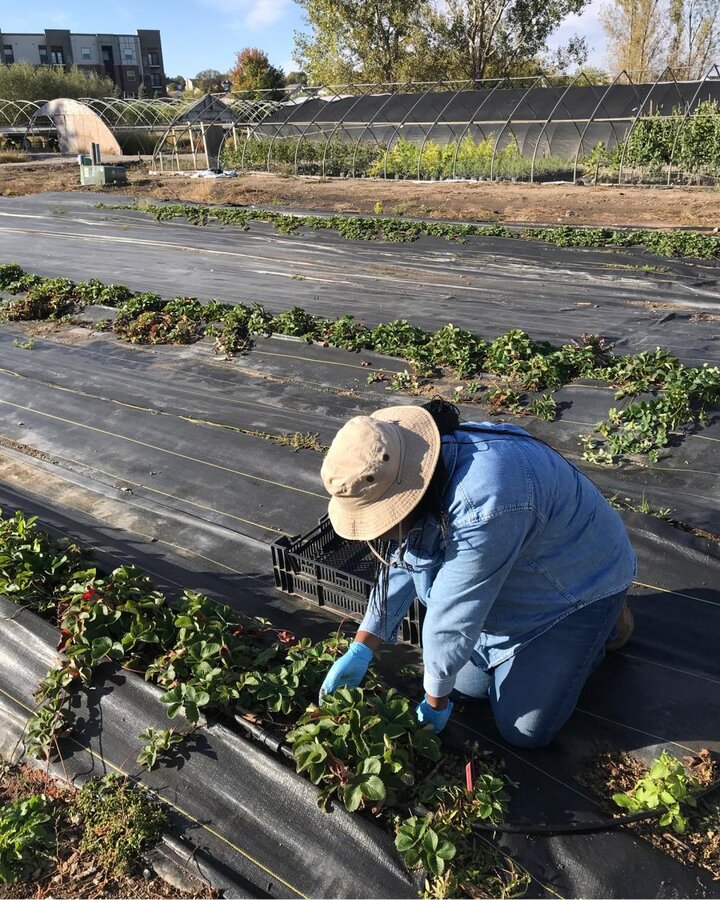
Figure 1. Graduate student Judy harvesting stolons on October 15, 2021.
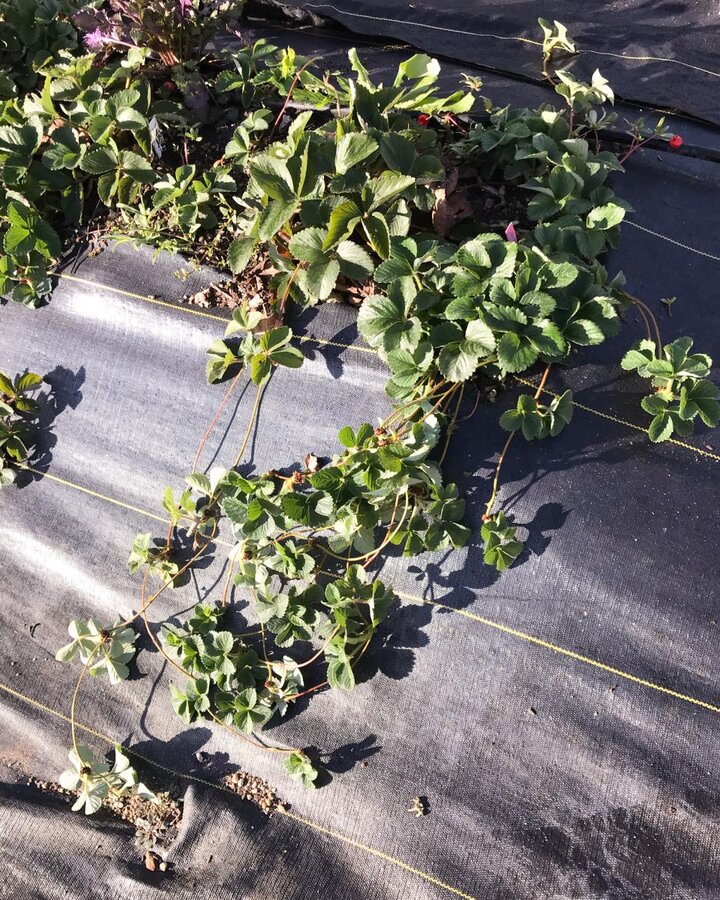
Figure 2. Plantlets used to clonally propagate strawberries.
November 2021
On Friday, November 12, 2021, all plants (crowns) were removed from the field (Table 1) (Figures 1, 2). Ten crowns from each cultivar were processed for cold storage. Specifically, all soil was removed from roots and stem by dunking in water. Then all leaves were pruned off and crowns were laid on newspaper in open crates (Figures 3, 4,5). Crowns were Fig4then treated with BotryStop at labeled rates in order to prevent mold and mildew during storage. Last May, 30 plantlets for each cultivar were planted and stolons with plantlets were harvested three times (August, September, October) (column 2 Table 1). Overall, ‘Evie-2’ produced more crowns and more plantlets than the other two cultivars. However, give the whole area (approximately 900 square feet) occupied by these plants, all these cultivars produced enough crowns and plantlets to consider commercial production. On November 24, the ground was plowed, cleared of debris and black poly was laid down to promote solar pasteurization of the field (Figures, 6, 7, 8).
| Cultivar | Crown number | Total number of plantlets harvested | Total number of plantlets plus crowns harvested |
|---|---|---|---|
| Honeoye | 322 | 358 | 680 |
| Seascape | 198 | 573 | 771 |
| Evie-2 | 478 | 581 | 1059 |
Table 1. Total numbers of crowns and plantlets harvested in 2021.
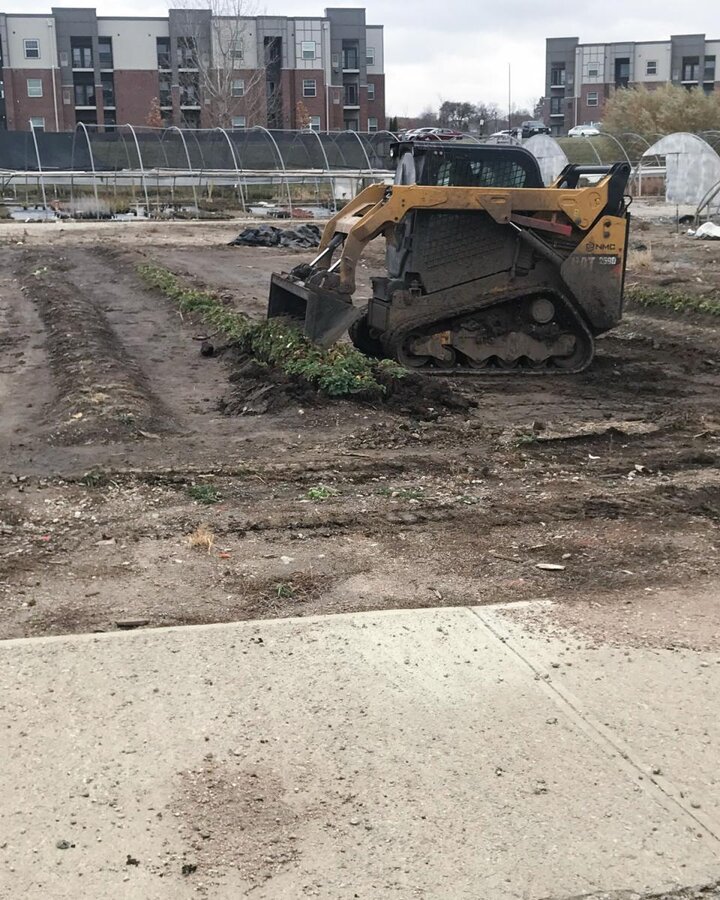
Figure 1. Small front-end loader lifting the crowns. Our crews then went in with shovels to pick up the crowns and shake the soil from the roots.

Figure 4. Pruned and washed large crowns that will go into cold storage.
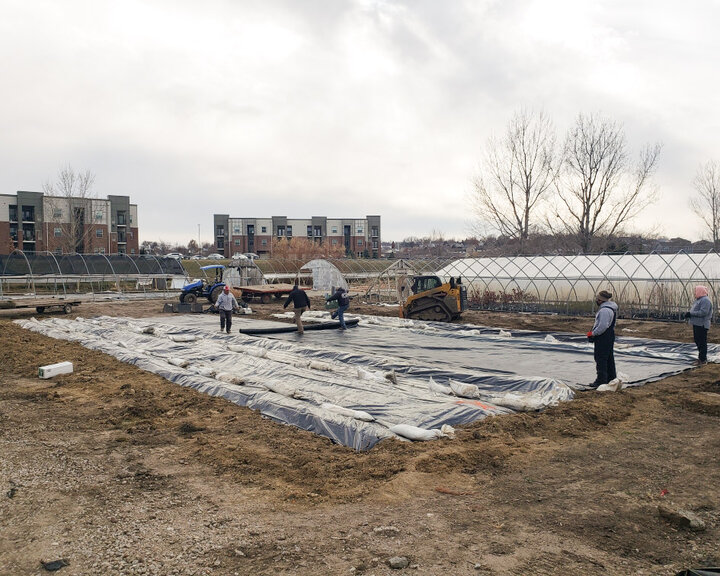
Figure 7. Four rows are mounded, established, and covered with 6 mil black ploy. Mounds of dirt and the sandbags keep the poly fitting tightly to the ground.
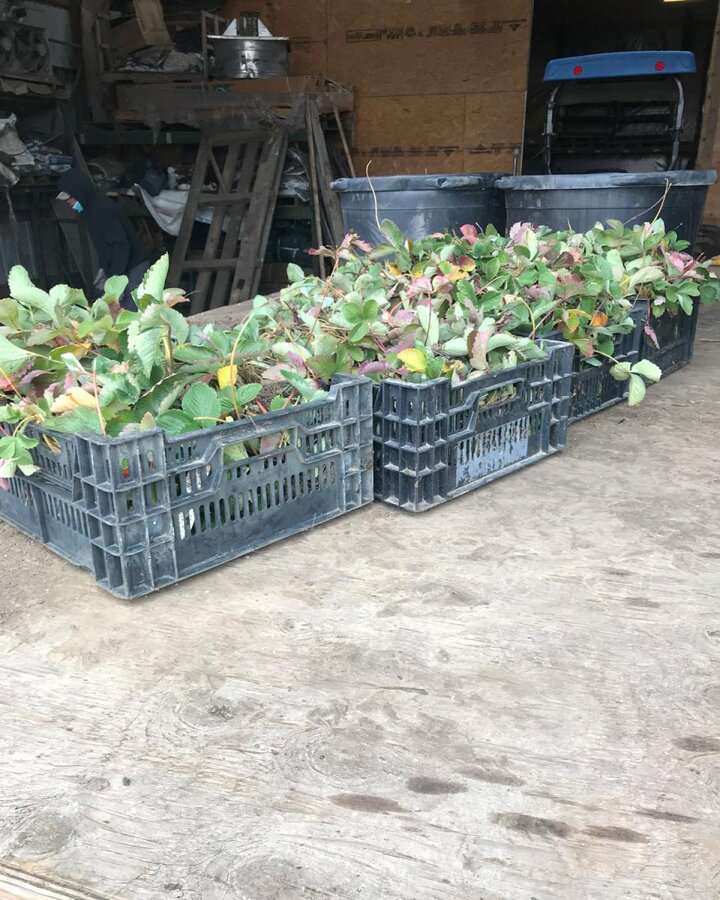
Figure 2. Crowns were loaded into crates and transported to a garage where it was warmer. This enabled us to count the crowns.
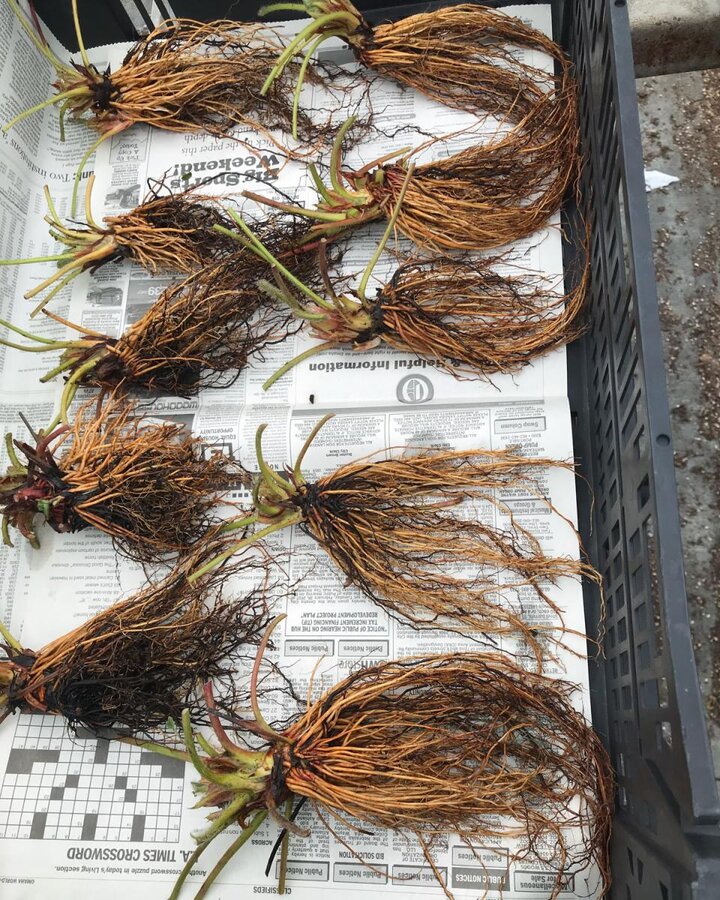
Figure 5. One crate of strawberry crowns ready to be treated with BotryStop before being put in cold storage.

Figure 8. The production area is covered and ready for solar pasteurization.

Figure 3. An example of one of the large crowns that was selected for cold storage.
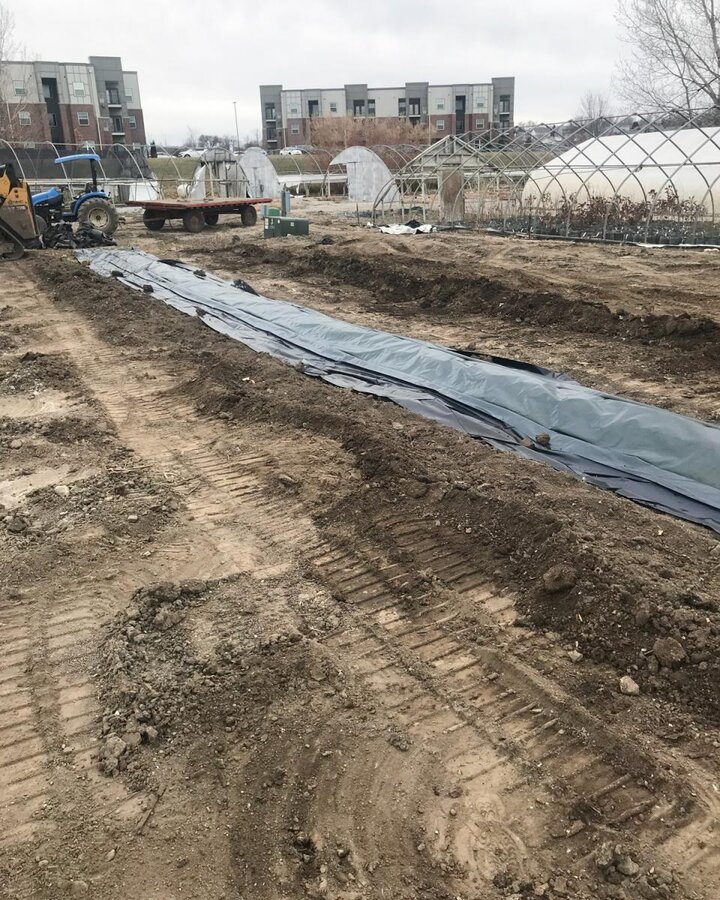
Figure 6. Preparing to identify and cover four rows for Spring 2022 planting and cover the rest of the field with weed barrier.
April 2022
On April 6, the plantlets were removed from cold storage and place in a 55 oF greenhouse. That week, they also received fertilizer (Greenway Biotech Strawberry Fertilizer with Micronutrients 8-12-37) at a rate of ¼ tablespoon per gallon. The dormant crowns were also assessed and found to have fungus (Figure 1). Whether this was due to the Botrystop biofungicide that was sprayed on them last fall or whether this was a new infection was uncertain.
On Tuesday, April 26, the black plastic was removed from the field, it was tilled and black weed barrier was placed over the rows (Figure 2). The baskets with the dormant crowns had been treated with Zerotol to remove the fungus and unfortunately found to be dead (Figure 3). It seems that the crowns cannot be stored with the other landscape plants in an open cold storage situation. It was clear that successful crown storage would only be obtained if they were isolated in a very clean, closed cold storage (like a refrigerator) with no other plant material.
The plantlets however all looked very good and 30 of each variety were planted (Figure 4) into a drip irrigation system (Figure 5). Soil samples were taken from the front, middle and back of the field (specifically the occupied rows) and were sent off for analysis. Initially the plantlets will be irrigated as needed. Once acclimated, they will be side dressed with 1 teaspoon of fertilizer per plant. Thirty may seem like a small number but open, irrigated field space is often limited. We are trying to determine if, like last year, less than 100 plants will produce enough plantlets to make growing strawberries plantlets physical feasible and economical.
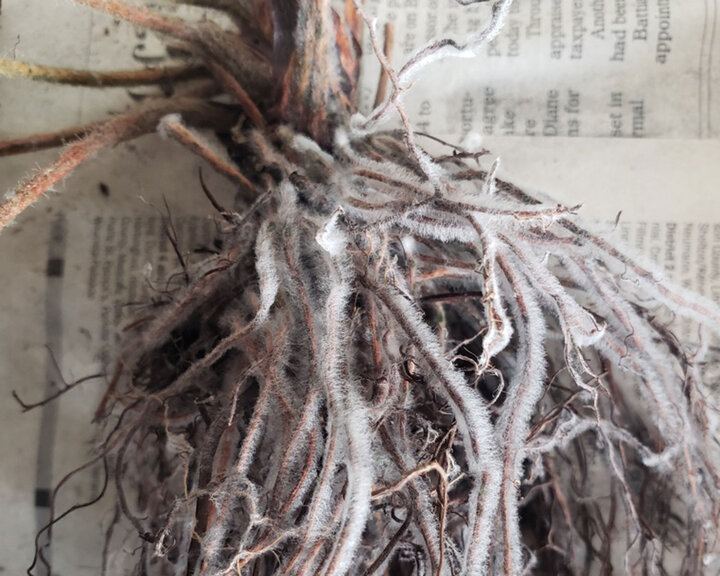
Figure 1. Closeup photo of fungus (presumed) on the strawberry dormant crowns.
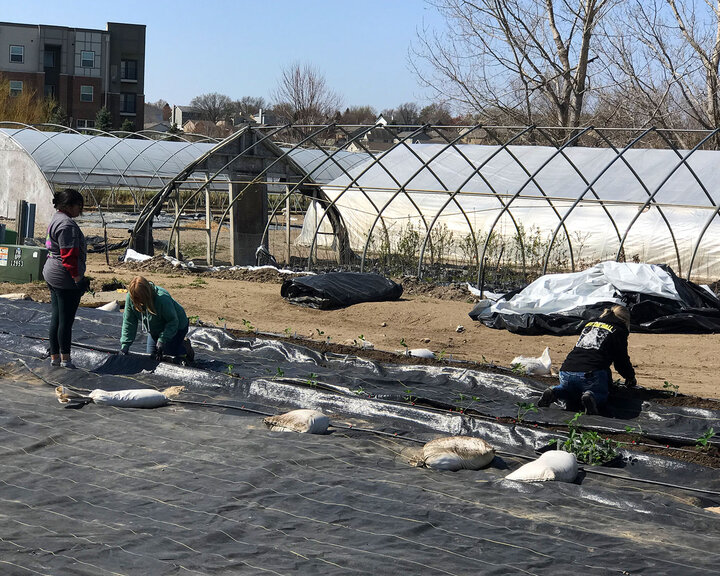
Figure 4. Planting the strawberry plantlets. They were spaced 16 inches apart. The cutting of the weed barrier, placing the tags and planting of the strawberries took 4 people about 2.5 hours.
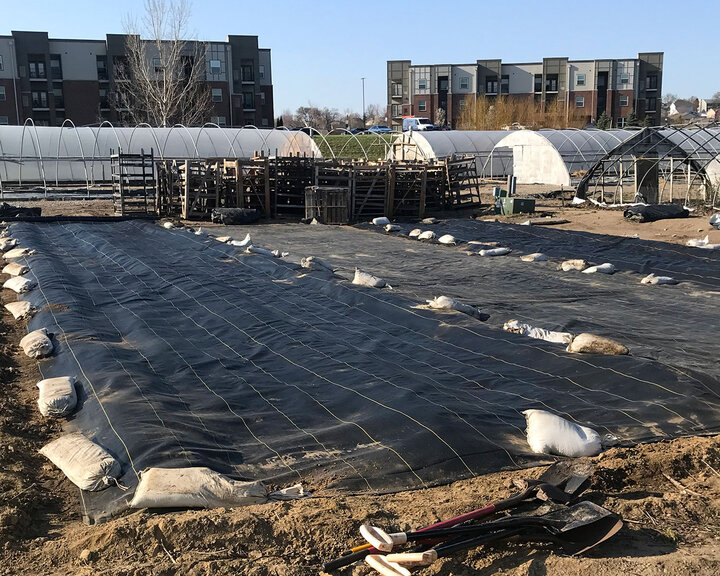
Figure 2. This field was under black plastic for 5 months for solar pasteurization. That black plastic was removed, the field was tilled and weed barrier was put in place.

Figure 5. Drip irrigation. The red pieces are the water emitters.
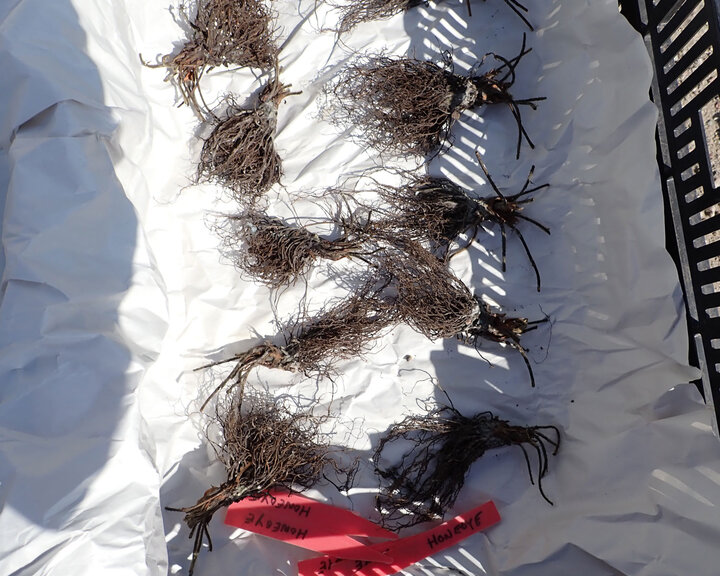
Figure 3. Despite a dip in Zerotol, some fungus persisted and the crowns themselves were dry and crispy – that is, showing no sign of living tissue.
May 2022
It has been 3 weeks since planting and all transplants have survived. All plants received 1 teaspoon of granular fertilizer on Tuesday, May 10. The fertilizer was side dressed.
In general, the plants look good, and some have flowers or fruit (Figures 1, 2, 3). However, the lower leaves are beginning to show a purpling which could be leaf scorch (Figure 4). The purpling is occurring mainly on ‘Seascape’ and ‘Evie-2’. As leaf scorch in strawberries is a fungus, we will remove the infected leaves, water regularly and deeply and keep weeds out of the beds rather than treat with a fungicide.

Figure 1. A view of the field showing ‘Seascape’ (left row) and ‘Evie-2’ (right row) plants.
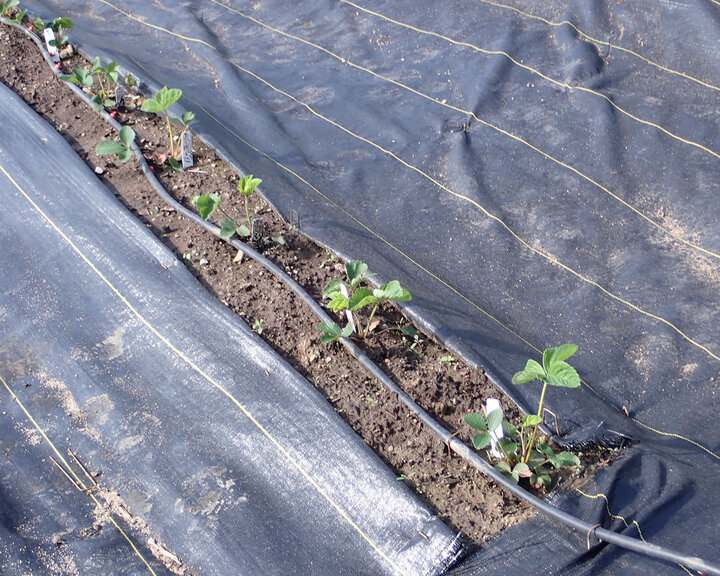
Figure 2. All plants were successfully transplanted and have started growing.
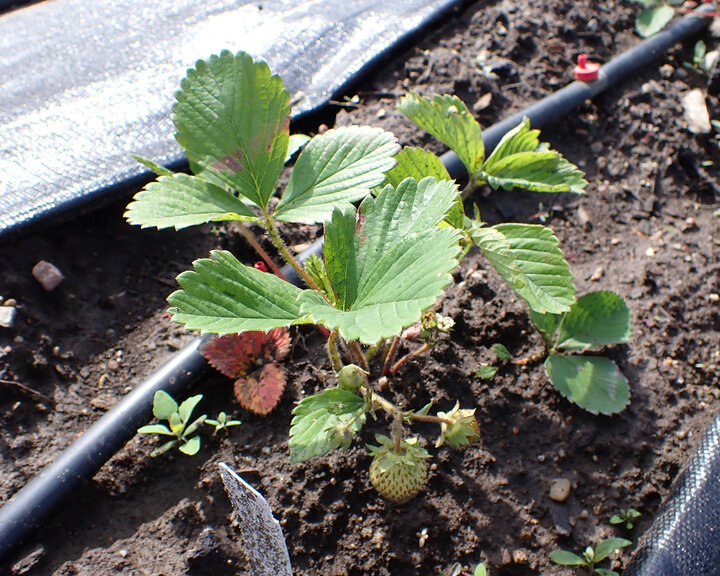
Figure 3. Flowers and fruit on one of the recently transplanted plants. This planting also indicates that if plants were purchased at a garden center and placed in home gardens, they would start flowering and fruiting.
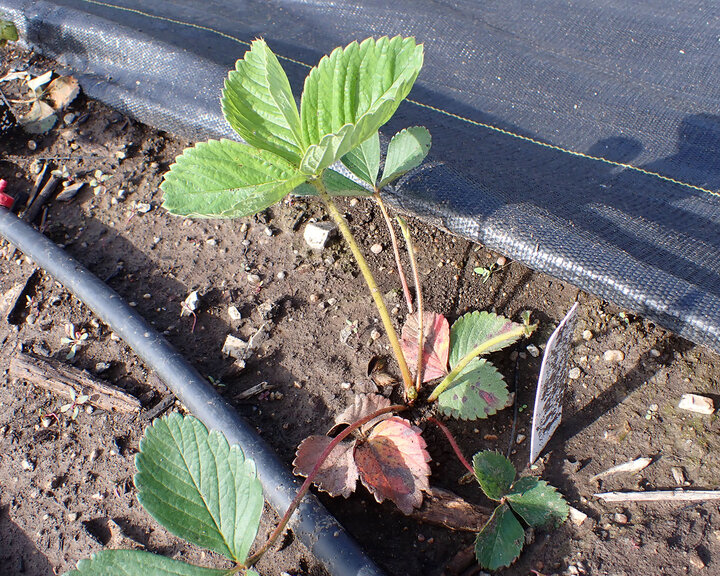
Figure 4. Leaf scorch on the bottom of leaves of a ‘Seascape’ plant.
June 30, 2022
On May 3, soil samples (taken across the field) were sent in for analysis. There were adequate amounts of organic matter, sulfur and zinc. Phosphorus and calcium levels were high. Soluble salts and sodium were satisfactory, but soil pH (7.7-8.0) and excess carbonate were high. This is probably what is causing the yellowing (iron deficiency) on the leaves of some of the plants (Figure 1). Nitrate N ranged from a low of 15.4 to 83.3 ppm. This may be what is causing the purpling of the leaves of some of the cultivars (Figure 2). ‘Honeoye’ plants did not show the purpling as much as ‘Evie-2’ and ‘Seascape’ plants (Figure 3, 4).
Samples of the purpling were sent to the Plant Diagnostic Laboratory at UNL. Some Mycospharella leaf spot was found, but nothing to indicate leaf scorch or leaf blight.
The crew had been removing the purple leaves and thus, plants were a lot smaller than last year and only had 1 or 2 flowers and fruit per plant. It was decided to apply a fungicide and stop removing purple leaves as it was affecting the overall growth of the plants.
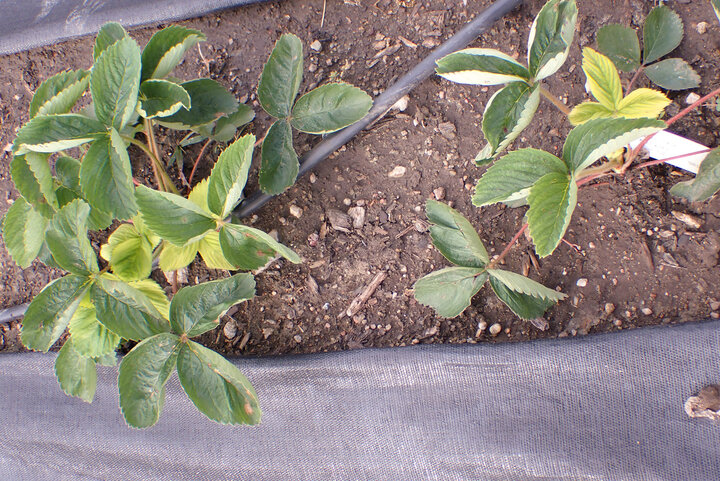
Figure 1. Strawberry plants with yellow leaves. This is probably due to the high soil pH limiting the availability of iron.

Figure 2. The leaves of third plant (from bottom) showing purple color.
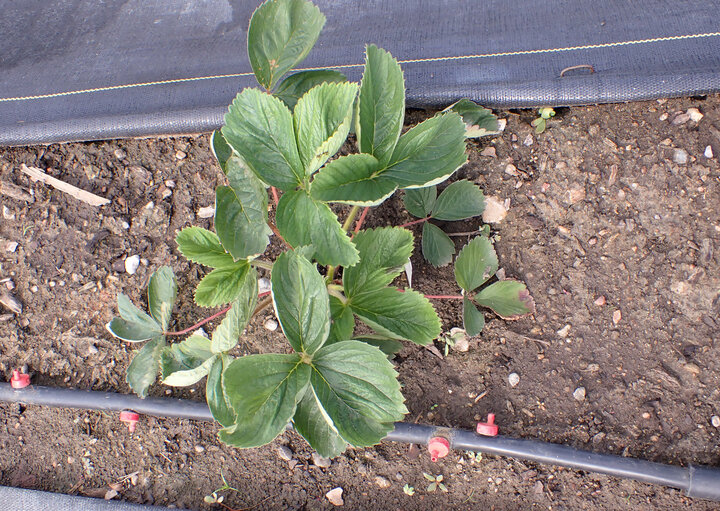
Figure 3. ‘Honeoye’ plant.

Figure 4. Field view of ‘Honeoye’ plants.
August 2, 2022
It has been about a month since the crew stopped removing leaves and side dressed and incorporated another tablespoon per plant of fertilizer. The strawberry plants have recovered nicely (Figure 1). They are no longer producing flowers, and this is probably due, in part, to the high temperatures this year. Most symptoms of leaf scorch disappeared and thus the reddening was probably due to nitrogen deficiency.
As this project is now mostly about propagation and plantlet sales, it was decided to harvest all the stolons that had at least 2 plantlets on them. These plantlets, if propagated would be ready for plant outside or into pots for indoor growing in early September (Figure 2.) Even though the plants were had less leaves than last year each plant produced at least 2 stolons with 2 plantlets on it (Table 1).
As we were concerned about the nutrient element levels in the soil, 9 additional samples were taken. The points selected for sampling were the north end of each row, the middle of each row and the south end of each row (Figure 3). Soil tests results showed that nitrogen and magnesium were low and phosphorus and copper were high. This implies a change of fertilizer, for future plantings, from the 8-12-32 that was used to a fertilizer containing more nitrogen and less phosphorus such as a 20-5-30.
| Cultivar | Number of plants | Number of stolons harvested | Number of plantlets from the stolons |
|---|---|---|---|
| Honeoye | 30 | 66 | 143 |
| Seascape | 30 | 77 | 171 |
| Evie-2 | 30 | 70 | 198 |
Table 1. The number of stolons and plantlets harvested from strawberry cultivars Honeoye, Seascape and Evie-2.
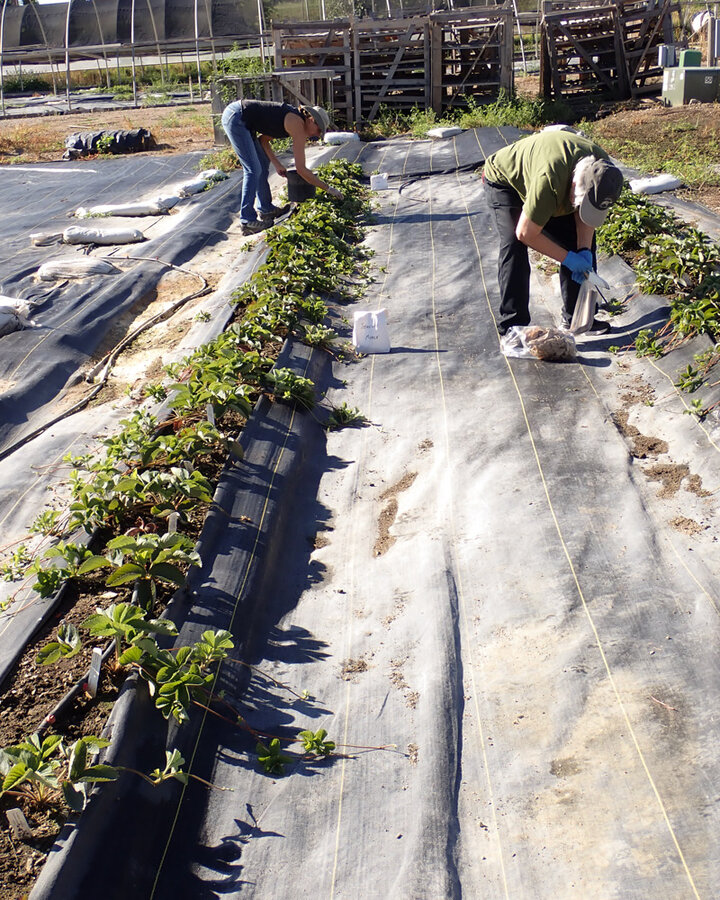
Figure 1. Pulling the stolons away from the plants for harvest.
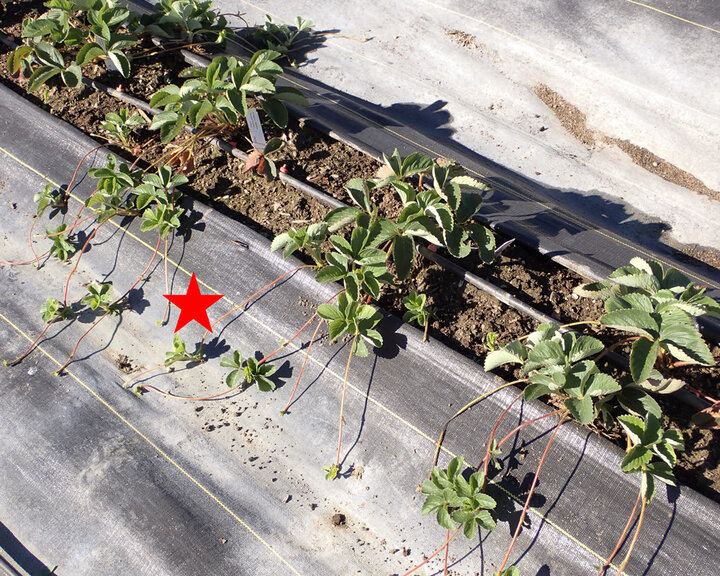
Figure 2. Strawberry plant with stolons and plantlets (red star).
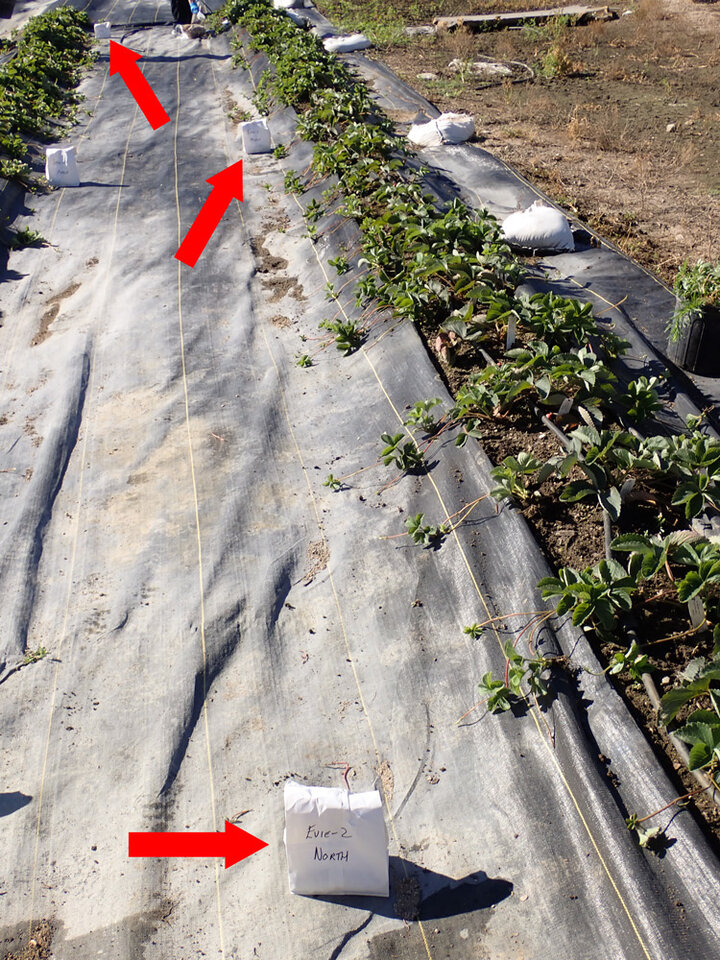
Figure 3. White bags containing the soil samples (red arrows).
September 22, 2022
This was our final harvest of stolons and plantlets. All plants had continued to grow well (Figure 1, 2, 3) and produce stolons. For all 3 cultivars about 2 plantlets were present on each stolon (Table 1.) However, ‘Evie-2’ produced more stolons and thus more plantlets that were suitable for propagation. It usually takes 3-4 weeks for these plantlets to root.
| Cultivar | Number of plants (originally) | Number of stolons harvested | Number of plantlets from the stolons |
|---|---|---|---|
| Honeoye | 30 | 202 | 410 |
| Seascape | 30 | 217 | 554 |
| Evie-2 | 30 | 335 | 622 |
Table 1. Final harvest of all stolons and plantlets. Mother plants were left in the ground.

Figure 1. View of the field. ‘Seascape’ plants is towards the middle. ‘Evie-2” plants are on the far right.

Figure 2. ‘Honeoye’ plants.
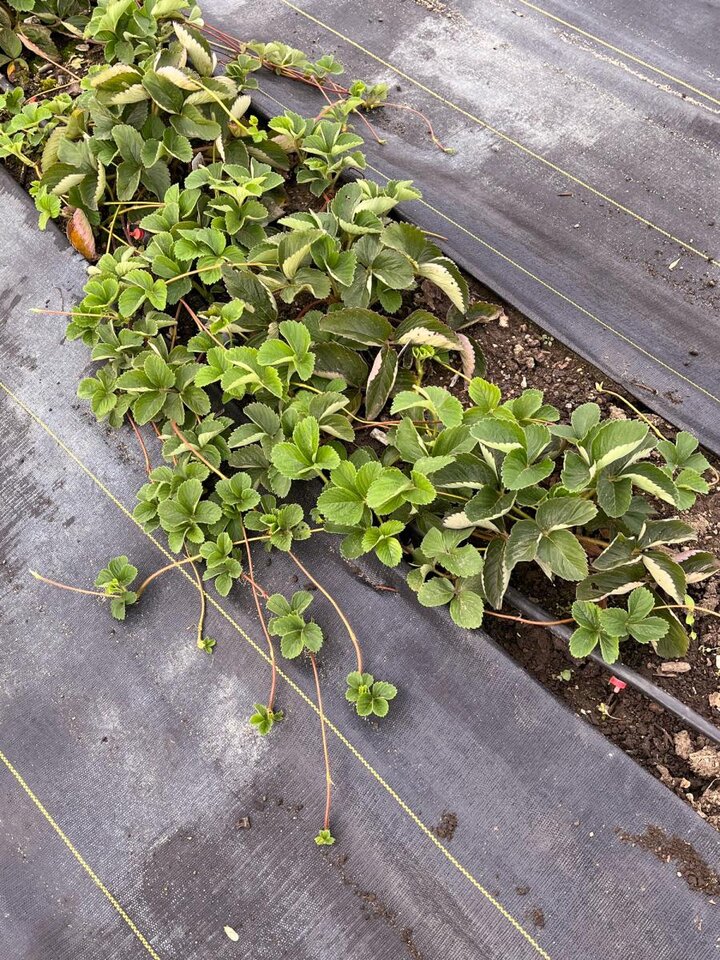
Figure 3. Close up of stolons with plantlets on the strawberry plants.
